From The Soho News, November 26, 1980. — J.R

The Perfumed Nightmare
A film by Kidlat Tahimik
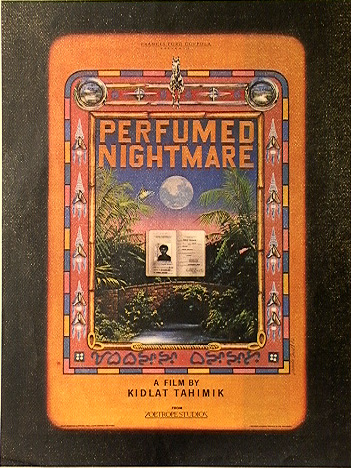
An odd, elusive 1971 Filipino filibuster, a first feature that somehow disassembles more than it assembles, Mababangong Bangungot (The Perfumed Nightmare) has a nearly total absence of “technique” — pacing, composition, acting, rhythm, budget — that is inextricably bound up with its subject, an all-around ambivalence about American knowhow. This makes it intermittently sluggish to watch, and theoretically fascinating to think about. Combining autobiography with fantasy, “magical realism” with cornball folklore and enchantment (with American technology) with disenchantment, it’s as unremittingly screwball as a house built of chewing gum wrappers and cigarette packs.

Don’t go expecting anything remotely decadent, despite the fancy title: the movie is as pure and innocent as the driven snow. (Or almost — the filmmaker, unlike his movie counterpart, spent almost a decade in Europe.) Kidlat Tahimuik, who wrote, produced, directed, and stars in this doggedly homemade production, presents himself as the driver of a brightly painted taxi-bus in his native Filipino village. He’s the proud possessor of a transistor radio, whose broadcasts lead him to become the founder of a local Werner von Braun Fan Club. Read more
From The Soho News, March 4, 1981. — J.R.
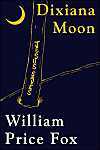
Dixiana Moon
By William Price Fox
Viking Press, $11.95
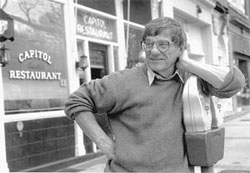
Any kind of sales talk, no matter how witty or effervescent, eventually goes stale or rancid in your head — until it is replaced by a new slogan. This is what Dixiana Moon is all about, and, just as unavoidably, what it’s like: drifts of euphoria that gradually work their way up to nausea, peaking in a blissful forgetfulness that efficaciously clears the way for bright new ideas to come along. It is also what journalism — a quaint subcategory of advertising — is about and like, this review included: a laxative for the imagination intended to move goods as quickly as possible, straight through the digestive tract.
Dixiana Moon is a quick and agreeable read, no doubt about that. One way or another, the whole novel is about packaging. The narrator hero, young movie freak Joe Mahaffey, has a lovable dreamer of a father in rural Pennsylvania, who keeps repackaging a nightclub in different décor — French, Spanish, Irish, Italian, and so on — while Joe Jr., hoping to win the affection of Monica Murphy (an “executive dancer” whom he crosses profesional paths with in Manhattan’s Danceland), signs on as a salesman for a packaging outfits, and peddles polyethylene bags in diverse spots east of Pittsburgh. Read more
From the Chicago Reader (December 21, 2001). — J.R.
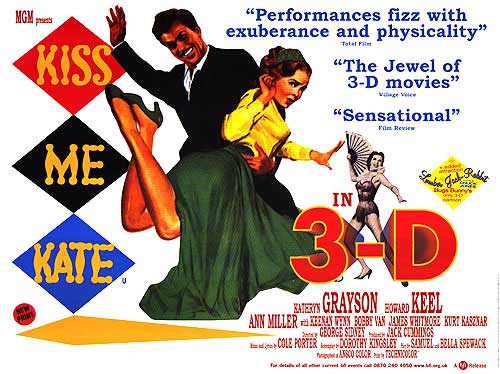
The Affair of the Necklace
Rating * Has redeeming facet
Directed by Charles Shyer
Written by John Sweet
With Hilary Swank, Adrien Brody, Jonathan Pryce, Christopher Walken, and Joely Richardson.
Ali
Rating *** A must see
Directed by Michael Mann
Written by Gregory Allen Howard, Stephen Rivele, Christopher Wilkinson, Eric Roth, and Mann
With Will Smith, Jon Voight, Mario Van Peebles, Jamie Foxx, Ron Silver, Jeffrey Wright, and Giancarlo Esposito.
Kate & Leopold
Rating ** Worth seeing
Directed by James Mangold
Written by Steven Rogers and Mangold
With Meg Ryan, Hugh Jackman, Liev Schreiber, Breckin Meyer, and Philip Bosco.
Kiss Me Kate
Rating **** Masterpiece
Directed by George Sidney
Written by Sam and Bella Spewack and Dorothy Kingsley
With Howard Keel, Kathryn Grayson, Ann Miller, Bobby Van, Keenan Wynn, James Whitmore, and Bob Fosse.
The Lord of the Rings: The Fellowship of the Ring
*** A must see
Directed by Peter Jackson
Written by Fran Walsh, Philippa Boyens, and Jackson
With Elijah Wood, Ian McKellen, Liv Tyler, Viggo Mortensen, Sean Astin, Cate Blanchett, and John Rhys-Davies.
The Majestic
Rating 0 Worthless
Directed by Frank Darabont
Written by Michael Sloane
With Jim Carrey, Martin Landau, Laurie Holden, David Ogden Stiers, James Whitmore, and Jeffrey DeMunn. Read more

One of the best films of James Benning, one of this country’s leading experimental filmmakers, is this multifaceted look at the landscape and history of Utah (or Deseret, as the Mormon Church prefers to call it). Benning condenses 93 news stories from the New York Times from 1852 to 1992 (read offscreen by Fred Gardner) and sets them against contemporary Utah landscapes, the shots changing with each sentence. Benning’s eye for evocative beauty is as sharp as ever, and his complex invitation to the viewer to create a narrative space between his separate elements keeps this 1995 film continually fascinating. 82 min. (JR) Read more
From the San Diego Reader (June 15, 1978). Not one of my best reviews, and certainly not a favorite, but I’m reprinting it, after some hesitation, as part of the record, with only minor re-edits. I came to write this through my acquaintance with Duncan Shepherd, the film critic for the San Diego Reader from 1972 until late 2010 -– a protégé of Manny Farber who had followed him all the way from New York to southern California –- after I had been hired by Farber to return to the U.S. from London and take over his classes for two quarters in 1977 while he was on a Guggenheim fellowship, and then hadn’t been rehired there. Manny, as I recall, was mightily annoyed by this piece, and I can’t deny that some of our political arguments probably fueled the review, at least in part -– as well as some of the swagger in Farber’s prose, a regrettable influence on this occasion. (An afterthought: I was sharing a house with Raymond Durgnat around this time, and the “crazy mirror” metaphor in the final paragraph suggests to me now that he might have exerted some influence as well.) — J.R.
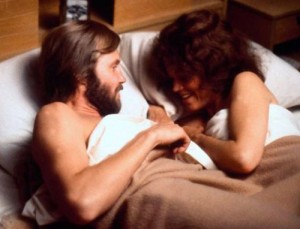
As a native of Alabama, I didn’t have to worry much about draft dodging in the late Sixties. Read more
From the Summer 1982 issue of Film Quarterly. — J.R.
Four Books on the Hollywood Musical

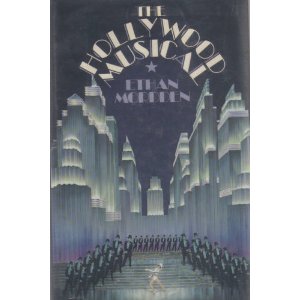
THE HOLLYWOOD MUSICAL, by Clive Hirschhorn. New York: Crown.
HOLLYWOOD MUSICALS, by Ted Sennett. New York: Harry N. Abrams.
THE HOLLYWOOD MUSICAL, by Ethan Mordden. New York: St. Martin’s Press.
GENRE: THE MUSICAL, edited by Rick Altman. London & Boston: Routledge & Kegan Paul (BFI Readers in Film Studies).
If the musical has nearly been vanquished as a popular form by the increasing subdivision of its audience into separate classes, age groups, and ethnic interests, these four books on the subject which nostalgically chart its heyday are similarly compartmentalized and exclusive. It seems inevitable that each of these four elegant receptacles for the most libidinal of American movie genres should address a different portion of our psyches: after all, if our society and minds are splintered, why shouldn’t our integral genres be as well?
The glib marketing strategies that aim each book at a somewhat different audience create the odd social effect of four high-rises, each constructed inside a separate ghetto — although the attractive coffee table books of Clive Hirschhorn and Ted Sennett might also be regarded with some justice as adjacent towers on somewhere like Sutton Place. Read more
From the August 29, 1997 Chicago Reader. This is one of the 13 pieces selected and translated into Farsi by Saeed Khamoush for the unauthorized collection of some of my Reader pieces that was published in Iran back in 2001, and the only one in that volume relating to Iranian cinema. — J.R.

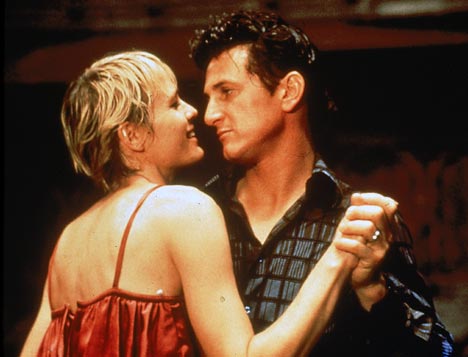
Gabbeh
Rating *** A must see
Directed and written by Mohsen Makhmalbaf
With Shaghayegh Djodat, Abbas Sayahi, Hossein Moharami, and Roghieh Moharami.
She’s So Lovely
Rating *** A must see
Directed by Nick Cassavetes
Written by John Cassavetes
With Sean Penn, Robin Wright Penn, John Travolta, Harry Dean Stanton, Debi Mazar, Gena Rowlands, and James Gandolfini.
To put it in simple market terms, Gabbeh packages Iran and She’s So Lovely packages John Cassavetes. Both films succeed admirably in taking on intractable and potentially uncommercial material — at least from the standpoint of mainstream Western audiences — and in making an alluring consumer object out of that encounter. Both take ideological shortcuts to make this alchemy possible, and that limits their artistic and expressive range, though this seems unavoidable given the marketplace barriers they’re bent on overcoming. The problem is in learning how to appreciate them for what they are without losing sight of what they aren’t. Read more
From The Soho News (August 4, 1981), very slightly tweaked on January 27, 2010. –J.R.
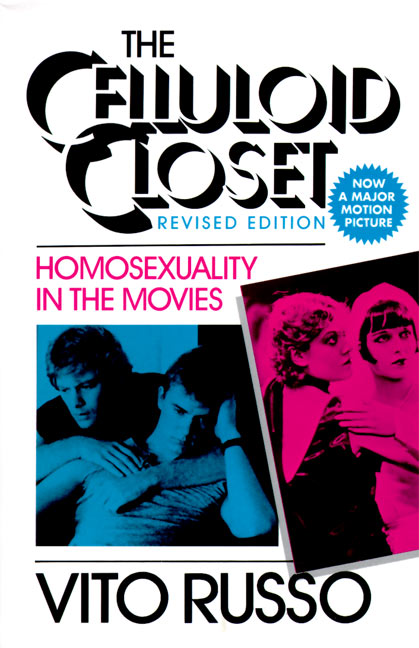
The Celluloid Closet:
Homosexuality in the Movies
By Vito Russo
Harper Colophon Books, $7.95
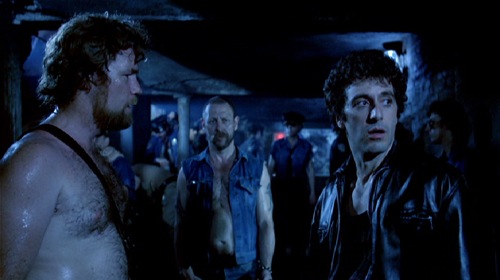
Want to read the first comprehensive study in English of homosexuality in the movies? Go hunt up Parker Tyler’s Screening the Sexes (1972). Prefer a more theoretical and political, less coterie-oriented approach? Try Richard Dyer’s first-rate Gays and Film (1975), which includes Caroline Sheldon on lesbians, Dyer on stereotyping, and Jack Babuscio on camp. Like something even more up to date, dealing with the “textual incoherence” of recent Hollywood movies like Cruising and Looking for Mr. Goodbar from a gay lib perspective? Check out Robin Wood’s interesting and fruitful article (no pun intended) in the current issue of Movie.
Where does this leave Vito Russo’s serious and ambitious The Celluloid Closet — which incidentally bears the same subtitle as Tyler’s book? Not so much in the lurch as the above list may imply. As the best researched and illustrated book on the subject — entertainingly and intelligently written in epigramatic journalese, and clearly backed up by years of patient fact-finding and interviewing — it deserves to be considered a significant reference point and a source of reference in the years to come. Read more
From the August 1985 issue of Video Times. — J.R.
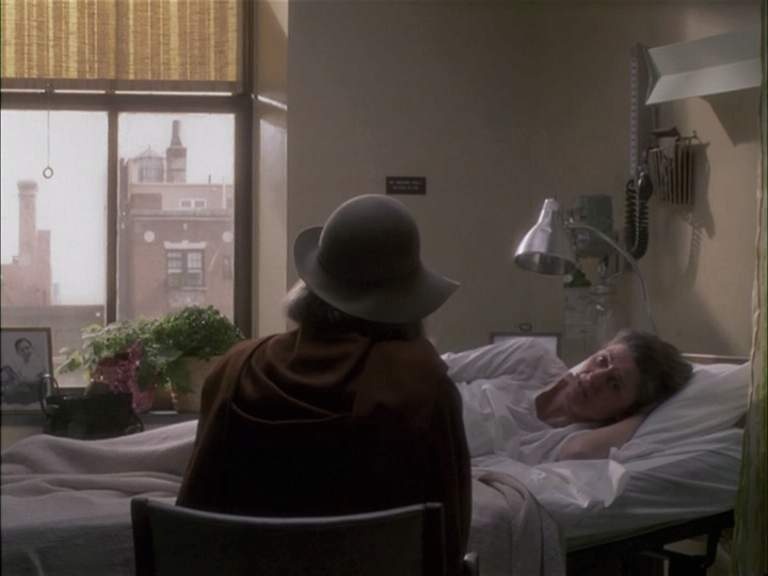
(1984), C, Director: Sidney Lumet. With Anne Bancroft, Ron Silver, Catherine Hicks, Carrie Fisher, Howard Da Silva, Hermione Gingold. 104 min. PG-13. Hi-Fi, CBS/Fox, $79.98. Three stars.
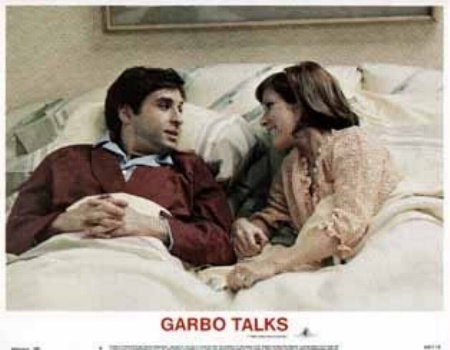
Perhaps the most delightful single aspect of thus warm, contemporary New York comedy is the degree to which it suggests anything but a movie of the present. From the animated cartoon behind the opening credits to the winsome conclusion in central Park, Garbo Talks registers more like a Hollywood film of the sixties or seventies than an expression of today’s sensibilities. (Where’s Poppa?, an absurdist comedy of 1970, provides a useful cross-reference.) The fact that scriptwriter Larry Grusin and director Sidney Lumet both seem perfectly aware of this adds a tang of irony to the film’s pleasure. They know, as we do, that lovable, eccentric radical like Estelle Rolfe (Anne Bancroft), who would have seemed almost commonplace in a movie 10 or 15 years ago, comes across as an audacious concept in the mid-eighties.
The plot of Garbo Talks is built around Estelle, and the role fits Anne Bancroft like a glove. The movie manages to milk the maximum out of her performance — one of the best in her impressive career — without keeping her onscreen any longer than is absolutely necessary. Read more
From Film Comment, November-December 1992. I’m not sure which of the stills directly below is printed backwards, so I’m including both of them.– J.R.
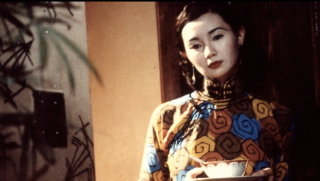

My 13th year at the Toronto Festival of Festivals reconfirmed my feeling that it’s large enough to satisfy many disparate and even contradictory viewing agendas. But even with a reported 320 films this year, it can’t be said to accommodate every taste. That is, one can generally count these days on the festival showing every new film by Paul Cox, Manoel de Oliveira, Henry Jaglom, Stanley Kwan, and Monika Treut, but not every new feature by Jean-Luc Godard, Jean-Pierre Gorin, Raul Ruiz, or Trinh T. Minh-ha (whose latest offerings were all absent this year) — or any work at all by Jean-Marie Straub and Danièle Huillet, Harun Farocki, or Leslie Thornton. Certain thresholds are maintained regarding difficulty, and while Toronto audiences are possibly the most polite and appreciative that I know of anywhere, the programmers don’t seem eager to test their limits. After the screening of his delightful and significantly titled Careful, Winnipeg weirdo Guy Maddin pointedly observed that if a Canadian sees a great movie, he or she says it’s pretty good, and if a Canadian sees a terrible movie, he or she says it’s pretty good. Read more
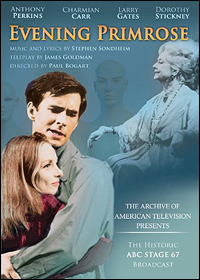
An extremely odd 1966 Steven Sondheim TV musical (1966) — 52 minutes, in black and white — adapted by James Goldman from an equally odd john Collier story of the same title about a poet (Anthony Perkins) who decides to live in a Manhattan department store and discovers an entire community of after-hours eccentrics already camped out there, including a wispy maiden (Charmian Carr) who’s spent most of her life there, whom he falls in love with and teaches how to read. Perkins, by the way, is a pretty delightful singer. The fact that part of this show was actually shot on location in and around a 42nd Street emporium is only part of what’s so strange about it. But I find it impossible to guess how peculiar it might have looked 44 years ago, because I’ve just seen it for the first time.
A good-quality, newly discovered kinoscope print of this ABC Stage 67 broadcast is what led to this recent DVD release. Among the useful and thoughtful extras is an extended interview with the now-retired director, Paul Bogart — a TV veteran who also directed Torch Song Trilogy back in 1988, and who offers a thoughtful autocritique, at once modest and apt, of his own contributions. Read more
From the Chicago Reader (May 13, 1988). — J.R.
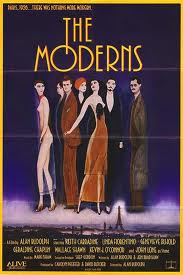
THE MODERNS
*** (A must-see)
Directed by Alan Rudolph
Written by Rudolph and Jon Bradshaw
With Keith Carradine, Linda Fiorentino, Geneviève Bujold, Geraldine Chaplin, Wallace Shawn, Kevin J. O’Connor, and John Lone.
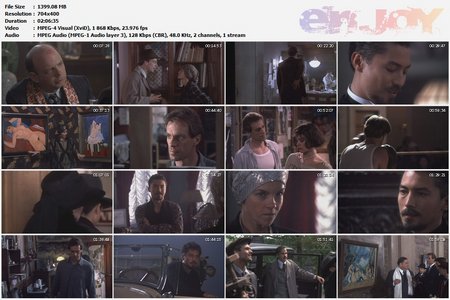
For its first hour, at least, The Moderns gives us an Alan Rudolph very nearly back at the top of his form, on a level that approaches that of his two masterpieces, Remember My Name and Choose Me. The effort isn’t sustained — and the movie encounters a number of booby traps, emerging more than a little battle scarred — but it still qualifies as far and away the most ambitious Rudolph movie to date. Painters and art critics who were offended by the treatment of art forgery in Orson Welles’s F for Fake will probably be even more outraged by Rudolph’s tracing of related ironies, set in what purports to be the Paris of 1926. But those who are will be missing something enjoyable.
Fundamentally a gifted stylist with only a couple of effective stories to tell — usually “romantic” yarns that progressively unravel their own artificiality, inviting the viewer to reassemble them — Rudolph has had an unusually scattered and elusive career. Read more
From Cineaste, Spring 1996. — J.R.

A dozen years ago, when his second feature, Stranger Than Paradise, catapulted him to worldwide fame, Jim Jarmusch seemed at the height of arthouse fashion. Having already known him a little before then, I could tell that the extent to which he suddenly became a figurehead for the American independent cinema bemused him in certain ways. Given the aura of hip, glamorous downtown Manhattan culture that seemed to follow him everywhere, how could it not? I can still recall a New York Times profile a few years back that was so entranced by his image that it suggested that, simply because Jarmusch chose to live in the Bowery, that neighborhood automatically took on magical, transcendent properties.
When Dead Man, his sixth feature, premiered at Cannes last year, it suddenly became apparent that Jarmusch’s honeymoon with the American press was over — although his international reputation to all appearances survives intact. There are multiple reasons for this, including Dead Man itself, and before getting around to this visionary, disturbing black-and-white Western — which I regard as his most impressive achievement to date — it’s worth considering what’s happened to the American independent cinema over the past decade, which has a lot to do with Jarmusch’s changed position in the media. Read more
From the March 14, 2003 Chicago Reader. — J.R.
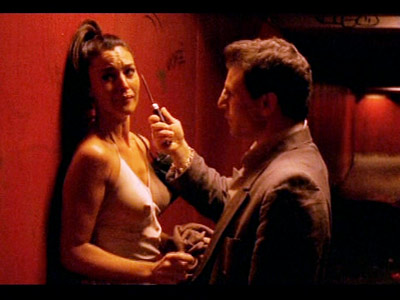

Irreversible
* (Has redeeming facet)
Directed and written by Gaspar Noe
With Monica Bellucci, Vincent Cassel, Albert Dupontel, Jo Prestia, and Philippe Nahon
Amen.
** (Worth seeing)
Directed by Costa-Gavras
Written by Costa-Gavras and Jean-Claude Grumberg
With Ulrich Tukur, Mathieu Kassovitz, Ulrich Muhe, Michel Duchaussoy, and Fontana Ion Caramitru.
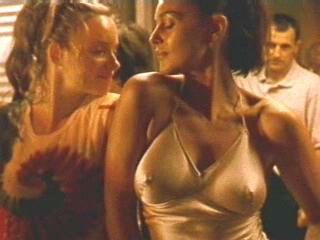
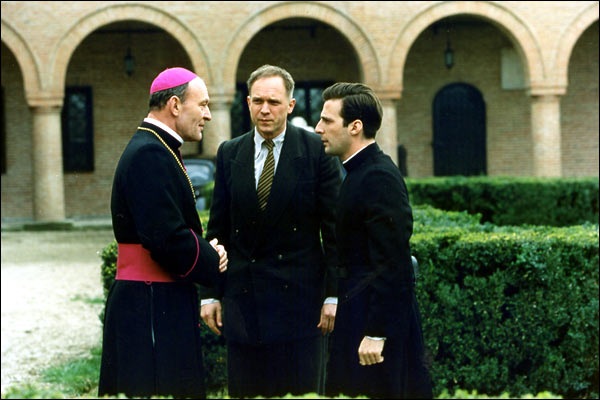
Why link an arty exploitation picture about rape, murder, and revenge with a sober adaptation of Rolf Hochhuth’s The Deputy, a 1960s German play about the failure of the Vatican to save Jewish lives during the Holocaust? One reason is to point out a critical difference between them. In Irreversible Gaspar Noe elects to show us everything — two faces being smashed to bloody messes, the heroine being raped and beaten for an agonizing ten minutes — while in Amen. (which played last week at the Music Box) Costa-Gavras shows his hero Kurt Gerstein (Ulrich Tukur), a newly commissioned SS lieutenant with a conscience, watching the gassing of Jews through a peephole with other officers but refuses to show us any part of what Gerstein sees.
The difference here concerns more than just etiquette. In the terms propounded by Claude Lanzmann’s Shoah (1985), it concerns ethics. Read more
From Video Movies (August 1984). -– J.R.
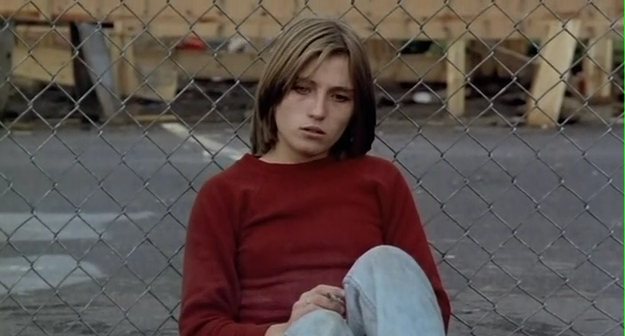
Out of the Blue
(1981), C. Director: Dennis Hopper. With Linda Manz, Dennis Hopper, Sharon Farrell, and Raymond Burr. 94 min. R. Media, $59.95.
When it was released, a friend wittily and succinctly described Out of the Blue as “Dennis Hopper’s Ordinary People.” Though this film didn’t start out as a Hopper movie (he signed on as an actor and took over direction after shooting started), it certainly has the Hopper flavor: relentlessly raunchy and downbeat, and informed throughout by the kind of generational anguish and sense of doom that characterizes both of his earlier films [Easy Rider and The Last Movie].
Hopper, one should recall, is a figure identified with the 1950s. He made his acting debut alongside James Dean in Nicholas Ray’s Rebel Without a Cause (1955). Conceived as a kind of punk remake of Rebel set in a contemporary working-class environment, Out of the Blue centers around Cindy “CeBe” Barnes (Linda Manz), an alienated 15-year-old punk who perpetually mourns the deaths of Elvis Presley and Johnny Rotten. Her mother, Kathy (Sharon Farrell), is a junkie who works at a cheap restaurant; her father, Don (Hopper), is a former trucker and an alcoholic finishing off a five-year stint in prison when the film opens. Read more



























